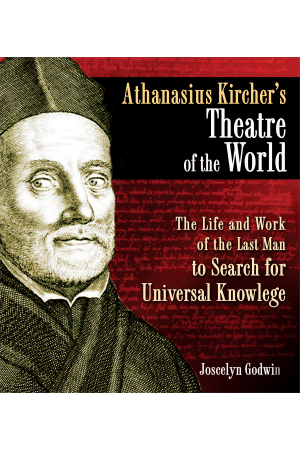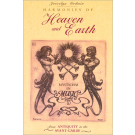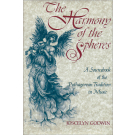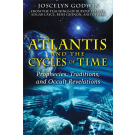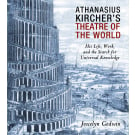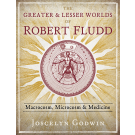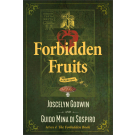Athanasius Kircher's Theatre of the World
The Life and Work of the Last Man to Search for Universal Knowledge
By (Author) Joscelyn Godwin
Availability:
In Stock
- Pages: 304
- Book Size: 9.88 x 11
- ISBN-13: 9781594773297
- Imprint: Inner Traditions
- On Sale Date: September 3, 2009
- Format: Hardcover Book
- Illustrations: 431 b&w illustrations
Athanasius Kircher was the last true Renaissance man, a Christian Hermeticist whose work also examined alchemy, the Kabbalah, and the Egyptian mystery tradition. Includes hundreds of stunning engravings that were a distinguishing feature of his work.
A major study of both the written and pictorial work of a neglected genius whose breadth of interest made him the last Renaissance man
• Fully examines every area of Kircher’s wide field of study and accomplishment
• Magnificently illustrated with the stunning engravings from Kircher’s work
Jesuit, linguist, archaeologist, and exceptional scholar, Athanasius Kircher (1602-1680) was the last true Renaissance man. To Kircher the entire world was a glorious manifestation of God whose exploration was both a scientific quest and a religious experience. His works on Egyptology (he is credited with being the first Egyptologist), music, optics, magnetism, geology, and comparative religion were the definitive texts of their time--and yet they represent only a part of his vast range of knowledge. A Christian Hermeticist in the mold of Marsilio Ficino and Pico della Mirandola, his work also examined alchemy, the Kabbalah, and the Egyptian mystery tradition exemplified by Hermes Trismegistus.
The Hermetic cast of Kircher’s thought, which was foreign to the concerns of those propelling the Age of Reason, coupled with the breadth of his interests, caused many of his contributions to be widely overlooked--an oversight now masterfully rectified by Joscelyn Godwin. It has been said that Kircher could think only in images. While this is an exaggeration, the stunning engravings that are a distinguishing feature of his work are included here so we may fully appreciate and see for ourselves the life work, philosophy, and achievements of “the last man who knew everything.”
• Fully examines every area of Kircher’s wide field of study and accomplishment
• Magnificently illustrated with the stunning engravings from Kircher’s work
Jesuit, linguist, archaeologist, and exceptional scholar, Athanasius Kircher (1602-1680) was the last true Renaissance man. To Kircher the entire world was a glorious manifestation of God whose exploration was both a scientific quest and a religious experience. His works on Egyptology (he is credited with being the first Egyptologist), music, optics, magnetism, geology, and comparative religion were the definitive texts of their time--and yet they represent only a part of his vast range of knowledge. A Christian Hermeticist in the mold of Marsilio Ficino and Pico della Mirandola, his work also examined alchemy, the Kabbalah, and the Egyptian mystery tradition exemplified by Hermes Trismegistus.
The Hermetic cast of Kircher’s thought, which was foreign to the concerns of those propelling the Age of Reason, coupled with the breadth of his interests, caused many of his contributions to be widely overlooked--an oversight now masterfully rectified by Joscelyn Godwin. It has been said that Kircher could think only in images. While this is an exaggeration, the stunning engravings that are a distinguishing feature of his work are included here so we may fully appreciate and see for ourselves the life work, philosophy, and achievements of “the last man who knew everything.”
Chapter 9
Music
Kircher’s mastery of music is one of his most unexpected traits. While musical talent typically shows itself in childhood and leads to a lifelong involvement with performance and/or composition, Kircher’s biography reveals nothing of the sort. Only once does he mention having had any musical training or inclination in his youth; he never tells anecdotes linking himself with music, and no biographer has shown him doing anything musical. Yet music is not easily learned in later life, while to compose counterpoint, play it on the keyboard, or read it from the score in one’s head is no light achievement at any age. Could Kircher do it?
He himself answers the question in the preface to Musurgia with a spirited defence, saying that just because he does not perform music or compose for money, it does not mean that he is incompetent. ‘The Prince of Venosa [Gesualdo] was not a musician by trade; so was he ignorant of it? Did the great kings Ptolemy and Alfonso, in not professing music or astronomy, know nothing of them?’ The idea, he adds, is insolent and absurd! From an early age he has worked at all the noble arts and sciences, including music both theoretical and practical, with attentive study and diligent practice.
While many pieces in Musurgia Universalis are unattributed and may be by him, Kircher states plainly that he composed the example of how to handle three-part writing. He says that the voices can begin together, or else one can lead and the others follow, observing the rules of harmony, diminution and syncopation. In its short compass, this Paradigma Melothesias omnibus numeris absolutae (example of free composition in all rhythms) contains at least eight different motifs, each treated imitatively and having its own ‘affect’ or mood. Typical of Kircher’s zeal to classify and display the variety of the world, he has here composed a musical microcosm, a sort of miniature specimen chest. Equally typical, he says that his piece ‘describes the soul moved towards God in harmonic affection’. As for the myriad other compositions and musical examples in Musurgia, Kircher admits that he had help, and no wonder: at over 1,200 pages it remained for centuries the most comprehensive work on music by a single author.
Musurgia opens with the anatomy of the musical parts of man and beast: the ear and the voice. The first engraving shows the outer ear and its parts, and the small bones of the middle ear, namely the hammer, the anvil and the stirrup. The small frames beneath compare these bones in the hearing apparatus of man, calf, horse, dog, hare, cat, sheep, goat, mouse and pig.
The text describes the three semicircular canals, but says that they have been omitted from the engraving because of the difficulty of illustrating them. More important to Kircher is the question of what sort of air is contained in these chambers, which he assumes to be totally isolated from the outside air. He thinks that it must be similar to the air that is treated in the lungs before it is allowed to reach the heart, or the air that enters the nostrils and must be ‘prepared’ before it can penetrate the brain. This treatment modifies the temperature and humidity of the air, enabling it to nourish the animal spirits. This leads him to consider theories of sound. Some say that it is a real and independent entity, while others, that it only exists as perception. He takes the middle path: sound really exists as waves propagated in the air, but also ‘the sounds of sonorous objects reach the auditive potential by the emission of species’.
In terms such as ‘species’ and ‘spirits’ we hear the struggle of Aristotelian metaphysics to bridge the gap between objective reality and subjective perception. The problems were of a different order when Kircher came to the vocal organs.
Who can easily explain the great variety of vocal production in animals? We hear the querulous voice of the toad, the plaints of the mourning dove, the cuckoo’s call, the sweet trilling of the nightingale, the piping of swallows, the cock’s crow, the trumpeting of elephants, the bleating of sheep, the lowing of cattle, the barking of dogs, and we wonder what meaning of love, hatred, anger, indignation, sorrow or lamenting lies in them.
Kircher defines the voice thus: ‘The voice is the sound produced by an animal from the glottis through the striking of exhaled air, for expressing the affects of the soul’. Consequently he excludes the buzzing or chirping of insects, and, for that matter, the voice that reputedly issued from the stomach of the Pythoness (the prophetic priestess of the Delphic Oracle). The voice of the frog was a borderline case, about whose cause even Aristotle was uncertain, but Kircher settled the matter by experiment. ‘We excited [a croak] in a recently dead frog by inserting a pipe through the ribs and into the trachea, then strongly blowing out the water collected in the gullet’. He concluded that the frog’s croak is not really a ‘voice’, but is caused by air violently expelled from the lungs and meeting with moisture: in short, a belch.
The often-reproduced plate of birdsongs shows the song of the nightingale transcribed into musical notation, and the songs of the cock, hen (B: laying an egg; C: gathering her chicks), cuckoo, quail and parrot. The latter has been taught to say ‘Hello!’ in Greek; but that is nothing compared to a bird of the lark species, called gallandra, as we read in the accompanying text. A learned Portuguese friar, Damianus à Fonseca, kept a pet gallandra in his ‘museum’ and trained it to rattle off the Litany of the Saints, and much else, in a quasi-human voice. Kircher would never have believed this, had not he and others witnessed the bird’s performance in Father Damianus’s cell on 16 March 1648.
Preface
Prologue: Interesting Times
1 Kircher's Life and Work: an Overview
2 Frontispieces
3 The Illustration of Kircher's Works
4 Antiquity Misread
5 Antiquity Preserved
6 Antiquity Imagined
7 Naturalia: Fire and Water
8 Naturalia: Air and Earth
9 Music
10 Machines of Past and Present
11 Machines: Magnetic and Optical
12 Maps and Plans
13 Exotica
14 Images of the Gods
15 Didactic Images
Athanasius Kircher's Writings
Bibliography of Works Cited
Sources of Illustrations
Index
Joscelyn Godwin is a professor of music at Colgate University and the author of many books on Hermeticism and music, including Cosmic Music, The Golden Thread, The Harmony of the Spheres, and Arktos. He is also known for his translations of the works of such figures as Fabre d’Olivet and Julius Evola as well as Francesco Colonna’s Hypnerotomachia Poliphili. He lives in New York State.
"Almost any modern work on archaeology, geology, science, medicine, or even Egyptian or Chinese history will present some intriguing fact . . . with a footnote referencing a work by Athanasius Kircher (1601-1680). The work of the polymath Jesuit richly rewards pursuit, and Joscelyn Godwin, a distinguished translator and professor of music at Colgate University, is the ideal guide. Not least of Godwin's services is placing Kircher in his intellecltual context. . . . What makes Kircher endlessly fascinating, as Godwin amply demonstrates, is the sheer breadth, depth, and expansiveness of his ever-curious mind. . . . Godwin and Inner Traditions deserve congratulations for a superb book, complete with bibliographies of Kircher's works and works about him."
Peter Skinner, ForeWord Reviews, Nov/Dec 2009
"There was a slightly surreal side to 17th century science, too . . . His [Athanasius's] mind resembled a chamber of curiosities: full of strange and astonishing objects."
Bloomberg.com, Dec 2009
"Here we have a virtual window into the mind of a 17th century genius. Athanasius Kircher's Theatre of the World fully and masterfully examines every area of Kircher's wide field of study and accomplishment. The large volume is magnificently illustrated with the stunning engravings from Kircher's work."
SirReadaLot.org, Nov 2009
"The great show in this beautifully produced book is the illustrations themselves, and the huge range of ideas they occupy. . . . Kircher might not have been hugely influential, might not have been the 'Renaissance Man' that, say, Leonardo was, but just looking at these pictures shows he ought to be more widely known. The beauty of many of the pictures is obvious, but with so many of them, covering such a broad array of inquiry, the effect of Godwin's book is to excite admiration for an extraordinary mind."
Rob Hardy, Top 50 Reviewer on amazon.com, Mar 2010
"Despite the constraints of his religious order, Kircher and his publishers engaged engravers, printers, and patrons to finance and produce a series of learned volumes on his subjects. He was at the heart of a global system of knowledge transfer, and was usually first to hear of geographical or scientific discoveries, as missionaries sent reports to him from all over the world. . . . The illustrations remain breathtaking . . ."
James Hamilton, The Spectactor, Nov 2009
"The reproductions are good, and Godwin deserves considerable praise for his close observation and background research"
Peter Carl, Times Higher Education Supplement, UK, Jan 2010
"Godwin's magisterial tome explains Kircher's many achievements (among them a prototype of the magic lantern, the ancestor of the slide-projector), and contains many of his astonishing illustrations, accompanied with detailed captions. He has been well served by his publisher, which has presented exemplary texts with masses of Kircher's fabulous images as a beautiful, absorbing and utterly wonderful book."
James Stevens Curl, Times Higher Education, Jan 2010
" . . . the main thing to say about this book is that it is a stupendously good piece of design. Every illustration is reproduced in exactly the right place; the captions are superbly apt and very clearly signaled; the sidebars are tactfully positioned and filled with exactly the right amount of information. The paper is heavy and rich, and properly bound. The author and the publisher have taken real, prolonged, and exhaustive pains to make a beautiful book, and succeeded."
The Guardian, Feb 2010
"Kircher obviously had his books of ideas copiously illustrated with expensive copper engravings . . . the engravings were largely ignored. But now they are shown to advantage in Joscelyn Godwin's new book, a wonderful theatrical feast of architecture, mythological figures, curiosities such as moon dials and sunflower clocks along with machines which embrace both the past and the future. This is not to mention images of fabulous cities and the deities which were believed to have inhabited them, plus a sensational engraving of the Tower of Babel."
Richard Edmonds, Birmingham Post, Oct 09
"Kircher's lasting legacy has been his prodigious outpouring of scientific tomes, copiously--at times fantastically so--illustrated by a variety of highly skilled artists to help articulate his often startling and marvelous postulations. . . . a charming, hugely knowledgeable and delightfully droll guide to this fascinating seventeenth-century personage who embodied the intersection of science, art, and the imagination. In the end, it is his unrelenting spirit of inquiry that stands out as the thing that we, as present-day readers, can learn from. Making the most of his situation, station, and formidable intellect, Athanasius Kircher embarked on a life-long, all encompassing scientific enterprise on a scale that is nothing short of staggering."
David Mathews, The Vienna Review, Mar 2010
" . . . a valuable addition to the history and philosophy of science shelves, offering valuable insight into the life of one of the world's last true polymaths."
C.G. Wood, Choice: Current Reviews for Academic Libraries, September 2010
“. . . an encyclopedic feast of extraordinary images, all fascinating, and many exotic . . .”
John Carey, Temenos Academy, March 2011
Peter Skinner, ForeWord Reviews, Nov/Dec 2009
"There was a slightly surreal side to 17th century science, too . . . His [Athanasius's] mind resembled a chamber of curiosities: full of strange and astonishing objects."
Bloomberg.com, Dec 2009
"Here we have a virtual window into the mind of a 17th century genius. Athanasius Kircher's Theatre of the World fully and masterfully examines every area of Kircher's wide field of study and accomplishment. The large volume is magnificently illustrated with the stunning engravings from Kircher's work."
SirReadaLot.org, Nov 2009
"The great show in this beautifully produced book is the illustrations themselves, and the huge range of ideas they occupy. . . . Kircher might not have been hugely influential, might not have been the 'Renaissance Man' that, say, Leonardo was, but just looking at these pictures shows he ought to be more widely known. The beauty of many of the pictures is obvious, but with so many of them, covering such a broad array of inquiry, the effect of Godwin's book is to excite admiration for an extraordinary mind."
Rob Hardy, Top 50 Reviewer on amazon.com, Mar 2010
"Despite the constraints of his religious order, Kircher and his publishers engaged engravers, printers, and patrons to finance and produce a series of learned volumes on his subjects. He was at the heart of a global system of knowledge transfer, and was usually first to hear of geographical or scientific discoveries, as missionaries sent reports to him from all over the world. . . . The illustrations remain breathtaking . . ."
James Hamilton, The Spectactor, Nov 2009
"The reproductions are good, and Godwin deserves considerable praise for his close observation and background research"
Peter Carl, Times Higher Education Supplement, UK, Jan 2010
"Godwin's magisterial tome explains Kircher's many achievements (among them a prototype of the magic lantern, the ancestor of the slide-projector), and contains many of his astonishing illustrations, accompanied with detailed captions. He has been well served by his publisher, which has presented exemplary texts with masses of Kircher's fabulous images as a beautiful, absorbing and utterly wonderful book."
James Stevens Curl, Times Higher Education, Jan 2010
" . . . the main thing to say about this book is that it is a stupendously good piece of design. Every illustration is reproduced in exactly the right place; the captions are superbly apt and very clearly signaled; the sidebars are tactfully positioned and filled with exactly the right amount of information. The paper is heavy and rich, and properly bound. The author and the publisher have taken real, prolonged, and exhaustive pains to make a beautiful book, and succeeded."
The Guardian, Feb 2010
"Kircher obviously had his books of ideas copiously illustrated with expensive copper engravings . . . the engravings were largely ignored. But now they are shown to advantage in Joscelyn Godwin's new book, a wonderful theatrical feast of architecture, mythological figures, curiosities such as moon dials and sunflower clocks along with machines which embrace both the past and the future. This is not to mention images of fabulous cities and the deities which were believed to have inhabited them, plus a sensational engraving of the Tower of Babel."
Richard Edmonds, Birmingham Post, Oct 09
"Kircher's lasting legacy has been his prodigious outpouring of scientific tomes, copiously--at times fantastically so--illustrated by a variety of highly skilled artists to help articulate his often startling and marvelous postulations. . . . a charming, hugely knowledgeable and delightfully droll guide to this fascinating seventeenth-century personage who embodied the intersection of science, art, and the imagination. In the end, it is his unrelenting spirit of inquiry that stands out as the thing that we, as present-day readers, can learn from. Making the most of his situation, station, and formidable intellect, Athanasius Kircher embarked on a life-long, all encompassing scientific enterprise on a scale that is nothing short of staggering."
David Mathews, The Vienna Review, Mar 2010
" . . . a valuable addition to the history and philosophy of science shelves, offering valuable insight into the life of one of the world's last true polymaths."
C.G. Wood, Choice: Current Reviews for Academic Libraries, September 2010
“. . . an encyclopedic feast of extraordinary images, all fascinating, and many exotic . . .”
John Carey, Temenos Academy, March 2011
HERMETIC STUDIES / ALCHEMY
Linguist, archaeologist, and exceptional scholar, Athanasius Kircher (1602-1680) was the last true Renaissance man. By profession a Jesuit priest, he made himself an authority on almost every subject under the sun. To Kircher the entire world was a glorious manifestation of God, and his exploration was both a scientific quest and a religious experience. His works on Egyptology (he is credited with being the first Egyptologist), music, optics, magnetism, geology, and comparative religion were the definitive tests of their time--and yet they represent only a part of his vast range of knowledge. A Christian Hermeticist in the mold of Marsilio Ficino and Pico della Mirandola, his work also examined alchemy, the Kabbalah, and the Egyptian Mystery tradition exemplified by Hermes Trismegistus. Kircher was the first to map ocean currents; the first to offer a comprehensive theory of vulcanism; the first to compile an encyclopedia on China, a dictionary of Coptic, a book dedicated solely to acoustics; the first to construct a machine for coding messages and another for composing music. His museum in Rome was among the most famous "cabinets of curiosities," visited by everybody in the intellectual world.
The Hermetic cast of Kircher's thought, which was foreign to the concerns of those propelling the Age of Reason, coupled with the breadth of his interests, caused many of his contributions to be widely overlooked--an oversight now masterfully rectified by Joscelyn Godwin. It has been said that Kircher could think only in images. While this is an exaggeration, 400 of the stunning engravings that are a distinguishing feature of his work are included here so we may fully appreciate, learn from, and see for ourselves the life work, philosophy, and achievements of "the last man who knew everything."
JOSCELYN GODWIN, musicologist and translator, is a professor of music at Colgate University. He first explored the life and work of Athanasius Kircher in 1979 in his book A Renaissance Man and the Quest for Lost Knowledge. Godwin was educated at Cambridge and Cornell Universities and has authored and edited many books on Hermeticism and music, including Cosmic Music, The Golden Thread, The Harmony of the Spheres, and Arktos: The Polar Myth. He is also known for his translations of the works of such figures as Fabre d'Olivet and Julius Evola and the first complete English translation of Francesco Colonna's Hypnerotomachia Poliphili. He lives in New York state.
Linguist, archaeologist, and exceptional scholar, Athanasius Kircher (1602-1680) was the last true Renaissance man. By profession a Jesuit priest, he made himself an authority on almost every subject under the sun. To Kircher the entire world was a glorious manifestation of God, and his exploration was both a scientific quest and a religious experience. His works on Egyptology (he is credited with being the first Egyptologist), music, optics, magnetism, geology, and comparative religion were the definitive tests of their time--and yet they represent only a part of his vast range of knowledge. A Christian Hermeticist in the mold of Marsilio Ficino and Pico della Mirandola, his work also examined alchemy, the Kabbalah, and the Egyptian Mystery tradition exemplified by Hermes Trismegistus. Kircher was the first to map ocean currents; the first to offer a comprehensive theory of vulcanism; the first to compile an encyclopedia on China, a dictionary of Coptic, a book dedicated solely to acoustics; the first to construct a machine for coding messages and another for composing music. His museum in Rome was among the most famous "cabinets of curiosities," visited by everybody in the intellectual world.
The Hermetic cast of Kircher's thought, which was foreign to the concerns of those propelling the Age of Reason, coupled with the breadth of his interests, caused many of his contributions to be widely overlooked--an oversight now masterfully rectified by Joscelyn Godwin. It has been said that Kircher could think only in images. While this is an exaggeration, 400 of the stunning engravings that are a distinguishing feature of his work are included here so we may fully appreciate, learn from, and see for ourselves the life work, philosophy, and achievements of "the last man who knew everything."
JOSCELYN GODWIN, musicologist and translator, is a professor of music at Colgate University. He first explored the life and work of Athanasius Kircher in 1979 in his book A Renaissance Man and the Quest for Lost Knowledge. Godwin was educated at Cambridge and Cornell Universities and has authored and edited many books on Hermeticism and music, including Cosmic Music, The Golden Thread, The Harmony of the Spheres, and Arktos: The Polar Myth. He is also known for his translations of the works of such figures as Fabre d'Olivet and Julius Evola and the first complete English translation of Francesco Colonna's Hypnerotomachia Poliphili. He lives in New York state.



